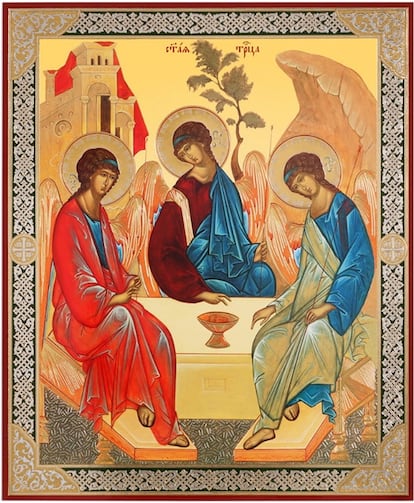Putin places Russia’s religious art at the service of geopolitics
The Russian president has handed the most precious icon of Russian antiquity, ‘The Trinity,’ to the Orthodox Church against the advice of restorers and art experts

The most precious icon of Russian antiquity — The Trinity, painted by Andrei Rublev in the 15th century — is to be handed over to the Russian Orthodox Church by virtue of a “decision” made by President Vladimir Putin. The transfer, which has been met with the opposition of many restorers and art experts across the country, could prove fatal for this treasured work of art. In addition to The Trinity, also by Putin’s decree, the Orthodox Church will receive the sarcophagus of the 13th-century Prince Alexander Nevsky, an exquisite silver work crafted in the 18th century and kept in the Hermitage Museum in St. Petersburg. The Trinity, meanwhile, had hung in the Tretyakov Gallery in Moscow since it was confiscated by the Bolsheviks in the late 1920s before its transfer to the Trinity Lavra of St. Sergius, the spiritual center of the Orthodox Church.
The Russian Orthodox Church has supported Putin’s war in Ukraine, blessing Russian soldiers and promising them salvation if they perish on the battlefield. There is a long-standing symbiosis between the state and the religious institution, which has basically replaced the Communist Party of the USSR as an ideology, but the transfer of cultural heritage belonging to the Russian people goes much further, as it not only instrumentalizes the religious sentiments of the faithful, but seems to respond to an obscurantist concept of religion.
In a press release, the Patriarchate of the Orthodox Church stated that Putin had acted in “response to numerous requests from the Orthodox faithful,” although in fact there is no record of any such requests. Patriarch Kirill of Moscow, the Primate of the Russian Orthodox Church, for his part, claimed that he had merely asked Putin to lend him the icon for two weeks for display in Moscow’s Cathedral of Christ the Savior, on the occasion of the feast of the Trinity on June 4. “We could only dream that this relic would be returned to the Church so that our people can pray before this sacred object,” Kirill said, adding that Putin had personally made the decision to return The Trinity and Nevsky’s sarcophagus.
Nevsky, who was canonized as a Russian Orthodox saint in 1547, is considered the protector of Russian soldiers. During Orthodox Easter this year, Putin visited his military commanders fighting in Ukraine and presented them with a copy of an icon. Historically, during difficult times for Russia, the country’s leaders have turned to the Orthodox Church for social cohesion. In 1943, Stalin altered his religious policy and urged the Orthodox Church to mobilize spiritually in the name of the USSR’s victory over Nazism.
“The President of the Russian Federation does not have the authority to dispose of objects belonging to the state, included in the Russian museum collections [...] and he has never had such authority,” writes Andrei Vorobev, who was head of the catalog of the Russian Federation Museum collections as well as deputy director of the Tretyakov Gallery. The expert is convinced that Putin’s decision has opened a Pandora’s box and “will necessarily be continued.” According to various laws and guidelines on Russian cultural assets, the transfer of state cultural heritage to the Orthodox Church requires that the transferred property does not constitute heritage that belongs to the Russian people as a whole and that a special agreement on “responsible custody” is concluded under the aegis of the Ministry of Culture.
In this case, the transfer has been made on the basis of a presidential “decision,” which as far as is known has not been formalized as an edict, although few doubt that while it is theoretically temporary, it will be approved at all the relevant levels and the cultural institutions will submit to the president’s wish, whatever their misgivings.
Elizaveta Likhacheva, the new director of the Tretyakov Gallery, has warned of the serious risks to preservation of The Trinity, which consists of “three poorly fastened together boards.” “The Trinity is the most important Russian contribution to Christian iconography” Lijacheva told the Tass news agency, pointing out that its value lies “not in the religious sense but the artistic sense.”
“Today the sacred significance of the monument is more important than its artistic value,” said Hermitage Museum director Mikhail Piotrovsky. “The Hermitage assumes that in the current geopolitical moment for the destinies of the country and social peace within it, the union of the relics with the sarcophagus [...] acquires a special meaning.” In 1922, Nevsky’s sarcophagus was separated from his remains, which after passing through the Museum of Atheism during the Communist era are now — as relics — under the custody of the Orthodox Church.
Russian art conservators have been warning for many years that works of art cannot be removed from museums, where they are kept in specific conservation conditions with stable temperatures and humidity, and in the case of The Trinity encased in a special glass chamber. The Trinity has only left the Tretyakov Gallery twice, when it was evacuated during World War II and last year when it was ceded to the Orthodox Church for a few days. Upon its return to its protective glass chamber, the gallery’s curators detected about 60 flaws in the work.
Russia is officially a secular state and the handing over of The Trinity to the Orthodox Church represents the sacrifice its artistic value in favor of its religious value, as the Church views these works above all as sacred products. Under legislation enacted in the 1990s, the state is gradually restoring part of the real estate owned by the Church before it was confiscated by the Communist regime. However, the government does not always satisfy the demands of the Church, which asks for much more than it can accommodate.
While many old churches in ruins dot the Russian landscape, the Orthodox Church is building new places of worship, often of dubious esthetic taste. In St. Petersburg, this construction drive is a response to the motto “a church for every neighborhood courtyard.” Moscow, for its part, has launched a building program called “two hundred churches.”
Both The Trinity and Nevsky’s sarcophagus will be preserved in accordance with the requirements of the Tretyakov and the Hermitage, according to the chairman of the Patriarchal Council of Culture and Metropolitan of Pskov, Tikhon, who is considered as Putin’s personal spiritual adviser.
“For the communists, culture took the place of religion. Today in Russia, religion has taken the place of culture. It is idiotic,” said award-winning film director Alexander Sokurov.
Sign up for our weekly newsletter to get more English-language news coverage from EL PAÍS USA Edition
Tu suscripción se está usando en otro dispositivo
¿Quieres añadir otro usuario a tu suscripción?
Si continúas leyendo en este dispositivo, no se podrá leer en el otro.
FlechaTu suscripción se está usando en otro dispositivo y solo puedes acceder a EL PAÍS desde un dispositivo a la vez.
Si quieres compartir tu cuenta, cambia tu suscripción a la modalidad Premium, así podrás añadir otro usuario. Cada uno accederá con su propia cuenta de email, lo que os permitirá personalizar vuestra experiencia en EL PAÍS.
¿Tienes una suscripción de empresa? Accede aquí para contratar más cuentas.
En el caso de no saber quién está usando tu cuenta, te recomendamos cambiar tu contraseña aquí.
Si decides continuar compartiendo tu cuenta, este mensaje se mostrará en tu dispositivo y en el de la otra persona que está usando tu cuenta de forma indefinida, afectando a tu experiencia de lectura. Puedes consultar aquí los términos y condiciones de la suscripción digital.
More information
Archived In
Últimas noticias
Most viewed
- Sinaloa Cartel war is taking its toll on Los Chapitos
- Oona Chaplin: ‘I told James Cameron that I was living in a treehouse and starting a permaculture project with a friend’
- Reinhard Genzel, Nobel laureate in physics: ‘One-minute videos will never give you the truth’
- Why the price of coffee has skyrocketed: from Brazilian plantations to specialty coffee houses
- Silver prices are going crazy: This is what’s fueling the rally











































